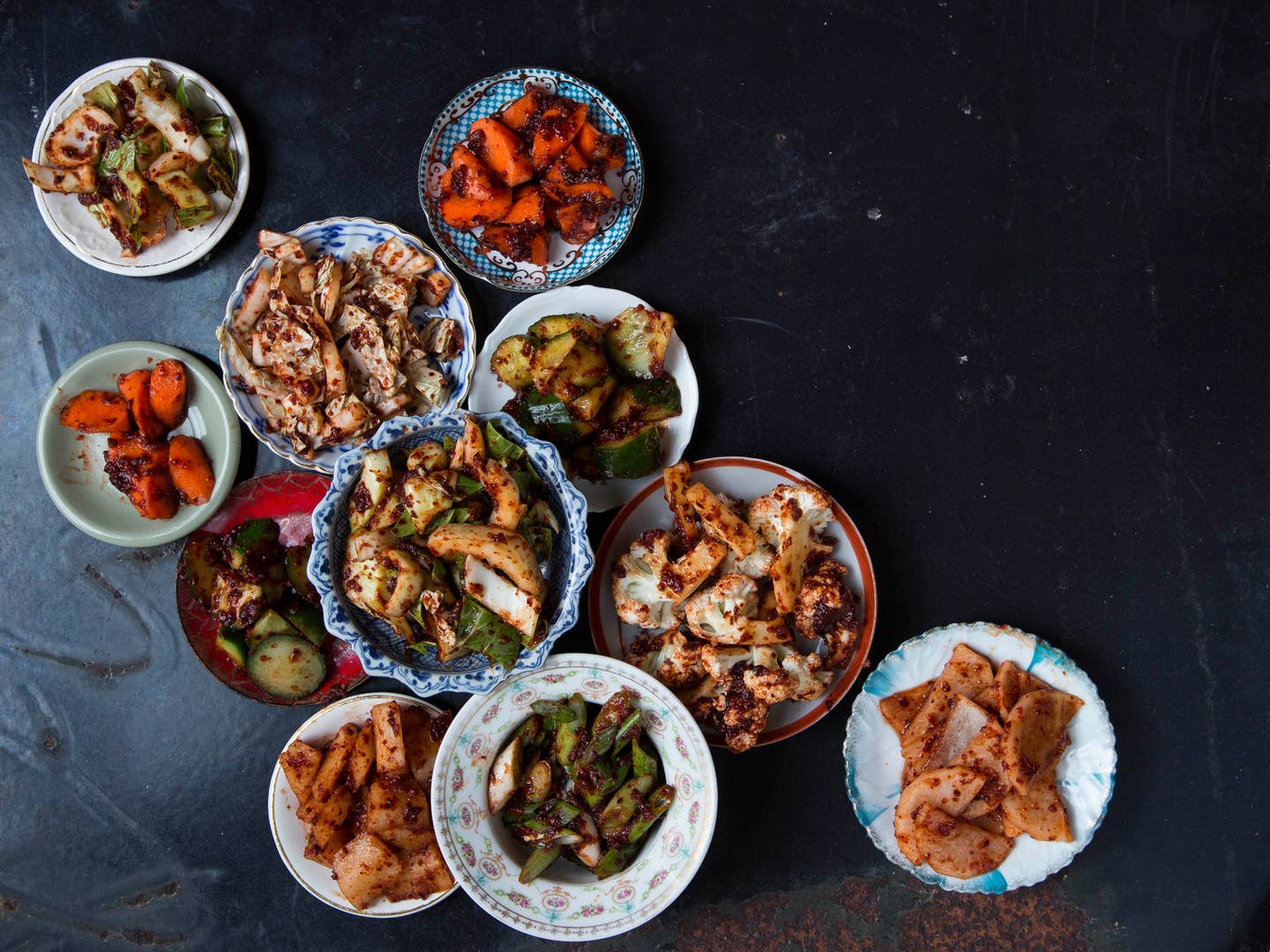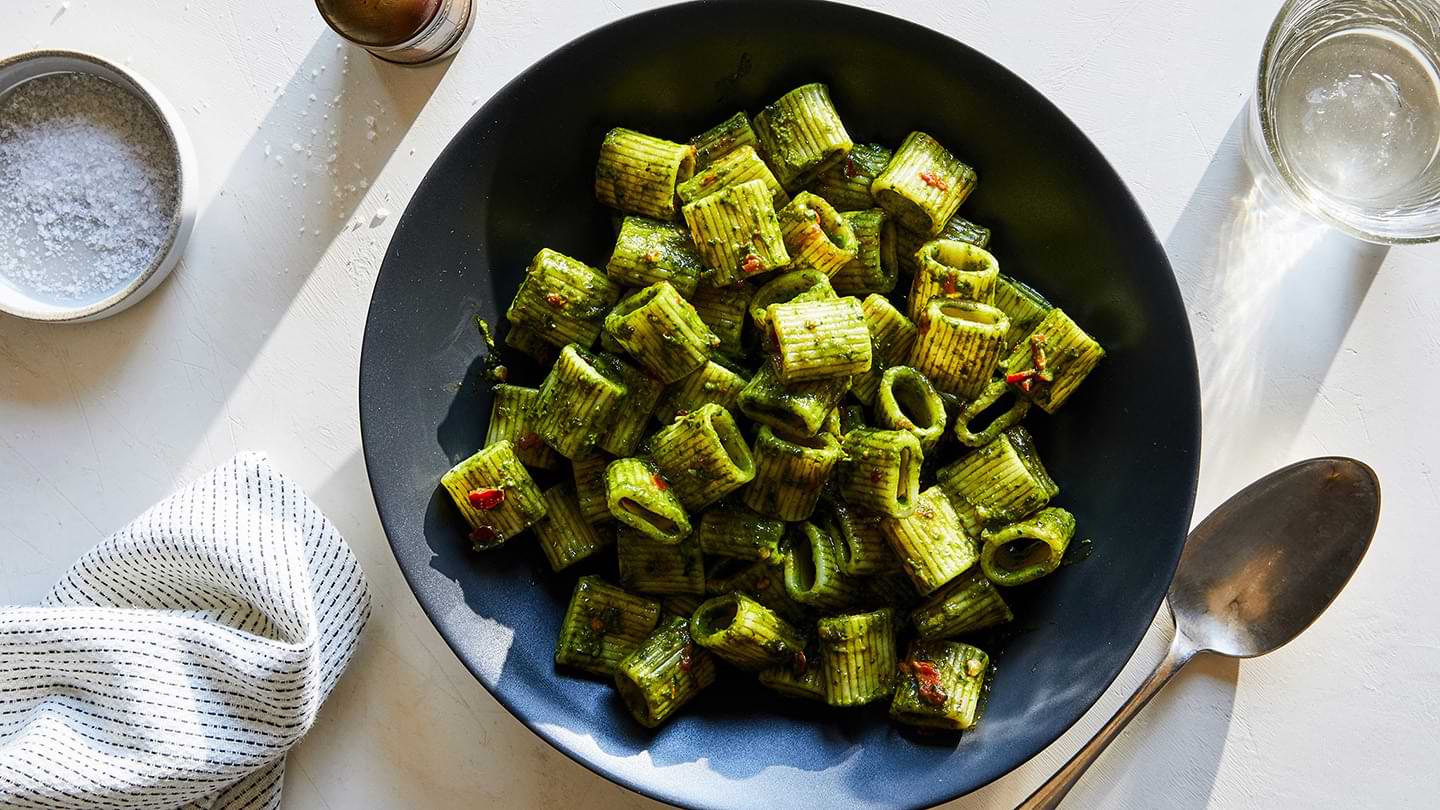
25 Essential Korean Recipes to Know and Love
Kimchi, Korean barbecue, and jjigae—your starter guide to the great wide world of Korean food
A delicious verve of heat runs through Korean recipes. The cuisine is as rich as it is communal, with meals often beginning with many side dishes known as banchan. Korean recipes are often accompanied by kimchi, a spicy fermented vegetable dish mostly consisting of cabbage and root vegetables and spicy seasoning. If you're feeling experimental, try making doenjang jjigae, a fermented soybean stew with a delicious combination of spices, vegetables, and tofu. Although the soybean stew is a great vegetarian option, Korean food is defined by meat. Whether it's double-fried chicken, a spicy pork belly stir fry, or classic kalbi beef ribs, Korean meat is a mouthwatering ingredient in the country's tastiest meals. To start, we've rounded up our favorite Korean recipes so you can enjoy the food of this fiery peninsula.
Korean Mung Bean Pancakes with Dipping Sauce (Bindaeduk Cho Kanjang)
These savory Korean pancakes are made from a batter of ground mung beans flecked with pork, scallions, and pungent kimchi. Get the recipe for Korean Mung Bean Pancakes with Dipping Sauce (Bindaeduk Cho Kanjang) »
Korean Fried Chicken
Double-frying chicken wings is the secret in Korean recipes to achieving the delicate, crackly crust that is the hallmark of this popular Korean specialty, made famous in this country at the Los Angeles restaurant Kyochon. Cathy Danh wrote about this snack in “The Other KFC” for our March 2010 issue. Get the recipe for Korean Fried Chicken »
jeyuk bokkeum stir fried pork
Gamjatang Sauce
Make this quick and easy dipping sauce as an accompaniment to Gamjatang (spicy pork neck and potato stew). This recipe is adapted from Koreatown: A Cookbook. Get the recipe for Gamjatang Sauce »
Korean Grilled Beef Ribs (Kalbi)
Pineapple juice sweetens and tenderizes beef short ribs in this classic Korean grilled dish. Ask your butcher for bone-in short ribs cut in half crosswise. Get the recipe for Korean Grilled Beef Ribs (Kalbi) »
Korean Rice Cakes
This spicy pork recipe comes from the kitchen of Arang, in New York, where it’s used to make ddukbokki, spicy rice cakes. Get the full recipe here. Get the recipe for Korean Rice Cakes »
Su Jung Kwa
Su jung kwa is a traditional Korean tea made from cinnamon, ginger, spices, sweet dried dates, and pine nuts that’s commonly served as an after-dinner drink or dessert. Chef Hooni Kim serves a chilled cocktail version at his New York restaurant Danji that gets a smoky kick from rye whiskey. Date jujubes, also known as red dates, Chinese dates, or Korean dates, are commonly used in Korean cuisine for their natural sweetness and purported medicinal properties. Both jujubes and dried persimmons can be found online and in most Korean and Chinese grocery stores. Get the recipe for Su Jung Kwa »
Korean Spicy Clam Soup
A simple, light soup not short on heat or spice. It’s traditionally served over a butane flame, so the broth remains hot, and a heavy dose of heat is delivered from two types of thinly sliced chiles. Get the recipe for Korean Spicy Clam Soup »
Gamjatang (Spicy Pork Neck and Potato Stew)
A classic hearty Korean stew made with meaty pork neck, potatoes, and nutty perilla seeds. Sesame seeds cannot be substituted for the perilla in this recipe; seek perilla seed, also called wild sesame seed, out at Asian markets. Optional but recommended: Serve this dish with its accompanying dipping sauce. Get the recipe for Gamjatang (Spicy Pork Neck and Potato Stew) »
Korean Noodles with Beef and Vegetables (Chap Chae)
When I was growing up in Korea, my grandmother would make chap chae for family reunions. Whenever she started stir-frying the shredded beef and vegetables together in a big wok, I would wander into her kitchen, wondering when the party was going to begin. The finished dish is festive and delicious. I love the combination of slippery sweet potato noodles turned golden from the cooking juices and soy sauce, crunchy vegetables, and tender, juicy beef. For my own family, chap chae is still a sign of celebration: Whenever I make it, my son walks in, asking when the party is starting. —Kyung Up Lim Get the recipe for Korean Noodles with Beef and Vegetables (Chap Chae) »
Korean Rice Cake
Korean rice cakes, known as songpyeon, are half moon-shaped dumplings that are stuffed with fillings like sweet potatoes, chestnuts, red beans, or nuts, and then steamed and served with honey. Get the recipe for Korean Rice Cake »
Fish Ssäm with Spicy Chile Sauce
Ssäm, which is Korean for “wrapped,” refers to the lettuce wraps that enclose spicy grilled fish in this recipe from Matthew Rudofker, executive chef at New York City’s Momofuku Ssäm Bar. Get the recipe for Fish Ssäm with Spicy Chile Sauce »
Kimbap
Korean kimbap is similar to Japanese sushi, but typically uses cooked or pickled ingredients. In this version, bulgogi (marinated beef) is paired with vegetables and egg. Get the recipe for Kimbap »
Pork and Kimchi Potstickers
Some zesty kimchi can bring your typical dumplings to the next level and enhance the pork filling’s savoriness. Get the recipe for Pork and Kimchi Potstickers »
Pork Belly Soft-Tofu Hot Pot
Freshly made tofu is traditionally used for this dish, but commercial silken tofu is a good substitute. The recipe is from Ktown’s popular B.C.D Tofu House. Get the recipe for Pork Belly Soft-Tofu Hot Pot »
Keep Reading
Continue to Next Story










